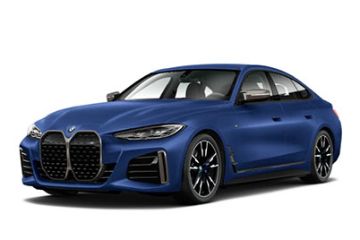![Donuts are so yesterday, BMW shows new 360-deg spin trick with first ever true M electric model 01]()
Currently, the BMW i4 M50 is the company’s only battery EV model to wear the vaunted tri-colour M badge. However, the i4 M50 is not a genuine M car in the way a M3 is.
There are several levels of hierarchy within BMW M GmbH and cars like the i4 M50 are analogous to the M340i, and they sit one rung below core M models like the M3, M4, or M5.
The question about BMW producing a true electric successor to the M3 and M4 is no longer an ‘if’ but ‘when.’ Now, BMW has provided further hints for its upcoming electric M car.
The company says it is now conducting test drives to develop the drive and chassis control systems for a new electric M xDrive system.
![Donuts are so yesterday, BMW shows new 360-deg spin trick with first ever true M electric model 01]()
Tests are now being conducted using a BMW i4 M50 that has been modified to accommodate a wider track width to fit the powerful motors. Of special note is the front-end of the test car, which BMW says uses modified body strut concepts from the M3 / M4.
Unlike a combustion engine model’s M xDrive that uses a transmission to control power distribution, this electric M uses 4 motors, one for each wheel, for the most precise control of torque and power delivery, achieving a level of vehicle dynamics that is simply not possible with a regular combustion engine model’s M xDrive.
“The fact that all four wheels are each driven by an electric motor opens up completely new possibilities for infinitely variable, extremely precise and at the same time very fast distribution of drive torque. Within milliseconds, the power and torque of the spontaneously reacting electric motors can be dosed so precisely that the load demand signalled via the accelerator pedal can be realised at a level of dynamics that is unattainable using conventional drive systems,” said BMW.
“The four motors are connected to a central, highly integrated control unit that permanently monitors the driving condition and the driver's wishes. The ideal power transmission to the road is calculated within milliseconds from the values for the accelerator pedal position, steering angle, longitudinal and lateral acceleration, wheel speeds and other parameters. The signals for this are transmitted just as quickly and directly via a multi-plate clutch and differentials to the four motors, which are able to implement them immediately and precisely,” it added.
A video released by the company showed the prototype i4 M50-based test vehicle doing a 360-degree spin within its wheelbase, something which can only be done by tracked vehicles like a tank, or a toy remote control car with individual motors for each wheel.
BMW didn’t say when will the production electric M car will be released, but considering that this is based on an i4, it’s reasonable to expect this to point to the next generation M3 / M4.
Also read: Hold on to your M3s, they might appreciate as next-gen BMW M3 could be an EV
But based on product lifecycle timeline, the ageing F90 M5 is due for a replacement soon, possibly as early as 2024. However between the M3 / M4 and the M5, the former two models’ smaller size seem to be more realistic candidates for EV transition.
But about the spin stunt, Mercedes-Benz had already demonstrated it earlier with their EQG.










